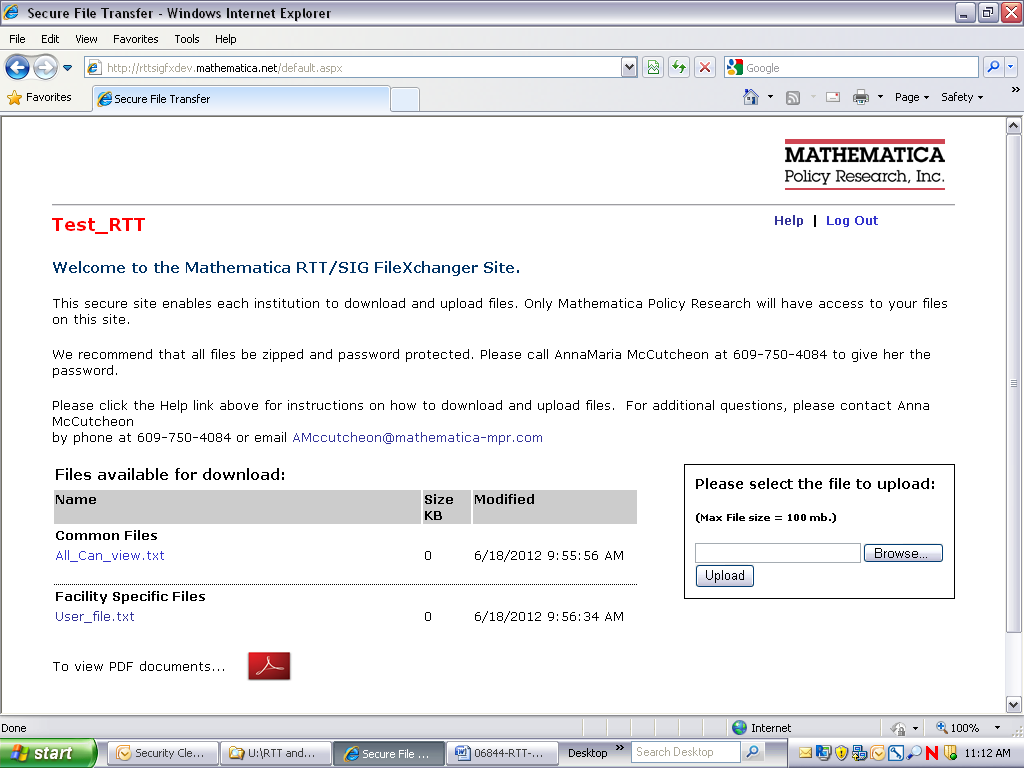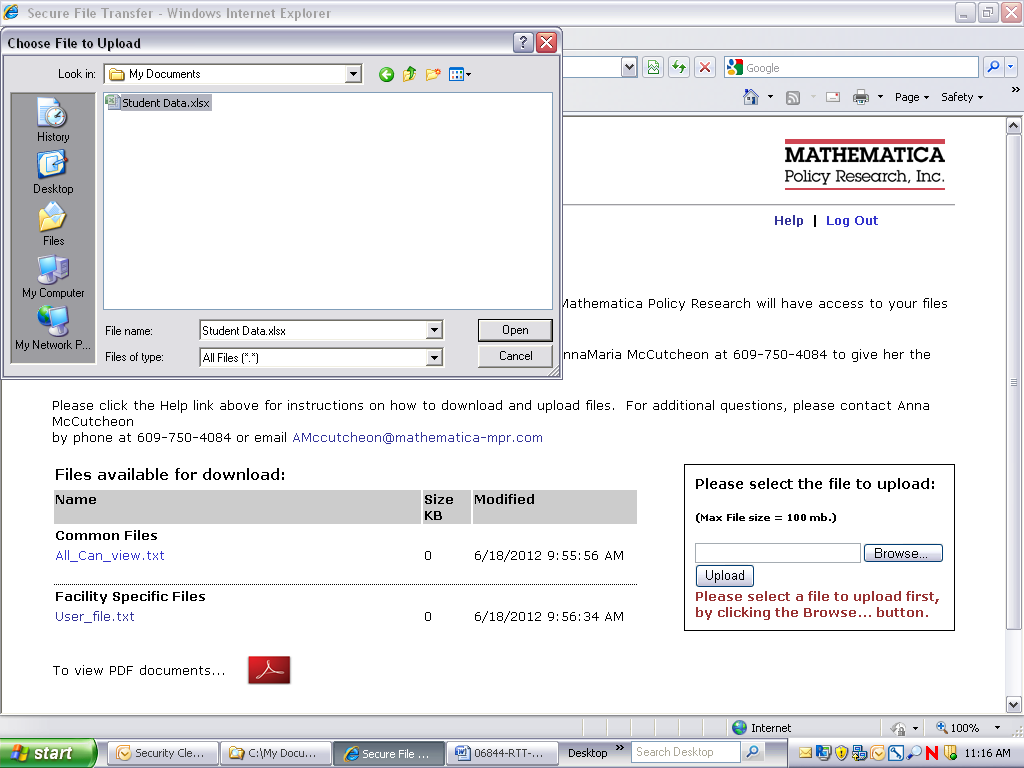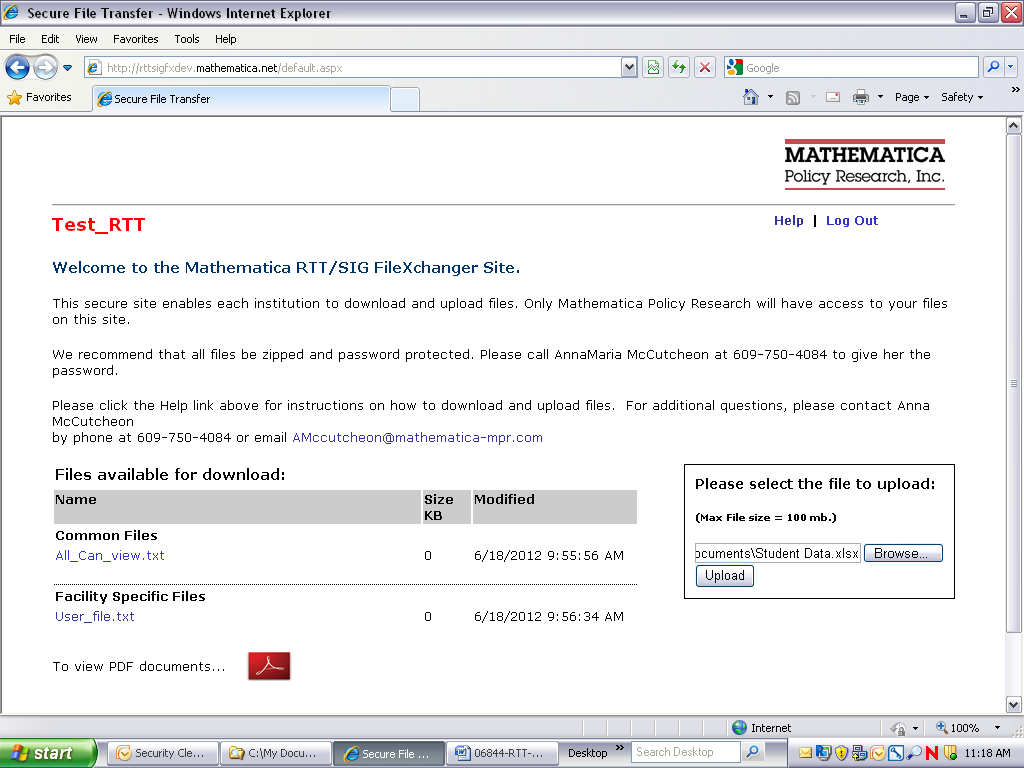Administrative Data on Teachers and Students
Impact Evaluation of Teacher Residency Programs
APPENDIX D ADMINISTRATIVE DATA REQUEST FORM
Impact Evaluation of Teacher Residency Programs
OMB: 1850-0960
Appendix D
Administrative Data Request Form
Subject: Administrative Data Request for the Impact Evaluation of Teacher Residency Programs
Thank you for participating in the Impact Evaluation of Teacher Residency Programs, a study that Mathematica and its partners, the National Center for Teacher Residencies and Decision Information Resources, are conducting for the U.S. Department of Education. The goal of the evaluation is to examine whether graduates from teacher residency programs remain in teaching longer than other teachers and are more effective at improving students’ achievement. This memo outlines our request for administrative data on teachers and students.
Table 1 provides an overall description of the administrative data requested and the timing of each request. During the fall of 2022 (Round 1 of data collection), we are requesting school and grade assignment data for teachers in the evaluation sample during the 2021–2022 school year (cohort 1), as well as demographic and state assessment data for students assigned to those teachers as of the beginning of the 2021–2022 school year. During the fall of 2023 (Round 2 of data collection), we are requesting school and grade assignment for teachers in the evaluation sample during the 2021–2022 or 2022–2023 school years (cohorts 1 or 2), as well as demographic and state assessment data for students assigned to cohort 2 teachers as of the beginning of the 2022–2023 school year.

Table 1. Administrative Data Collection Timeline
|
Sample
and school year of data requested, |
|
Data requested |
Fall
2022 |
Fall
2023 |
Teacher school and grade assignment data |
Data as of fall 2022 for teachers in the evaluation sample during the 2021–2022 school year (cohort 1) |
Data as of fall 2023 for:
|
Student demographic and assessment data |
Data for school years 2020–2021 and 2021–2022 for students assigned to cohort 1 teachers in fall 2021 |
Data for school years 2021–2022 and 2022–2023 for students assigned to cohort 2 teachers in fall 2022 |
We will work with your district to determine the appropriate timing of data delivery. In addition, we realize that your district might not collect some of the data elements listed in this memo. If a data element is not available in your district’s data systems, please let us know, and we will work with you to determine if another, similar data element may be used instead. When you provide data, please include a data dictionary or codebook that explains what the variables and values mean.
A. Educator School and Grade Assignment Data
Table 2 lists the educator school and grade assignment data we are requesting for teachers as of fall of the school year requested. If easier, you may provide these data for all teachers in your district and we will extract the data needed for the evaluation.

Table 2. Educator School and Grade Assignment Data
Data Element |
Description |
Notesa |
School year |
School year to which the record pertains (for example, 2022–2023 or 2023–2024) |
|
Employee ID |
Number that uniquely identifies the teacher across multiple files, records, and years. Please do not include a Social Security number. |
|
First and last name |
First and last name of each teacher |
|
School ID |
Number, such as state or district ID, that uniquely identifies the school where the teacher was assigned as of fall of the year requested. |
|
School name |
Name of school corresponding to School ID |
|
Staff category or job type |
Employment category, such as classroom teacher |
|
Grade(s) taught |
Grade(s) taught (if teacher) |
|
Subject(s) taught |
Subject(s) taught (if applicable) |
|
a The Notes column will be completed by study staff using information provided during the initial call to discuss the data request.
B. Student Demographic and Assessment Data
Table 3 lists the demographic data we are requesting for students.

Table 3. Student Demographic Data
Data Element |
Description |
Notesa |
School year |
School year to which the record pertains (for example, 2020–2021, 2021–2022, or 2022–2023) |
|
Student ID |
Number that uniquely identifies each student across multiple files, records, and years. Please do not provide Social Security numbers. |
|
School ID: beginning of the school year |
Number, such as a state or district ID, that uniquely identifies the school in which the student was enrolled at the beginning of the school year |
|
School name: beginning of the school year |
Name of school corresponding to School ID for beginning of school year |
|
School ID: end of the school year |
Number, such as a state or district ID, that uniquely identifies the school in which the student was enrolled at the end of the school year |
|
School name: end of the school year |
Name of school corresponding to School ID for end of school year |
|
Gender |
Student’s gender |
|
Year of birth |
Student’s year of birth |
|
Race |
Student’s race |
|
Ethnicity |
Whether student is Hispanic or Latinx |
|
Grade level |
Student’s grade level at the beginning of the school year |
|
Free and reduced-price lunch (FRPL) status |
Student’s eligibility for free or reduced-price lunch as of the beginning of the school year |
|
English learner status |
Student’s English learner status as of the beginning of the school year |
|
Special education status |
Student’s special education status, such as having an Individual Education Plan, as of the beginning of the school year |
|
Gifted education status |
Student’s gifted education status, such as being in gifted and talented classes for English language arts or math, as of the beginning of the year. |
|
a The Notes column will be completed by study staff using information provided during the initial call to discuss the data request.
Table 4 provides the specific state assessment data requested for students.

Table 4. Student Assessment Data
Data Element |
Description |
Notesa |
A. Math assessments |
||
School year |
School year to which the record pertains (for example, 2020–2021, 2021–2022, or 2022–2023) |
|
Student ID |
Number that uniquely identifies each student across multiple files, records, and years. Please do not provide a Social Security number. |
|
Math score on the state assessment for the school years requested, as available |
Student’s scale score on the math section of the state assessment. If a student retook the test, please provide the most recent score in that year; not the highest score. |
|
Math test grade level for each state test |
Grade level of math test taken by the student for each state test |
|
Math test description for each state test |
Name of math test. Please indicate if the student took a modified or alternate form of the state test. |
|
Math test language indicator (if other than English) for each state test |
For each state test, an indicator for whether the test was taken in a language other than English, such as Spanish |
|
Math test date for each state test |
Date of each math test taken by student. If no date is available, then “spring,” “fall,” or similar qualifier can be provided. |
|
Math test exemption or invalidation code, as applicable, for each state test |
Code or indicator for whether the student received an exemption from taking a math test (such as a medical exemption) or the test was found to be invalid |
|
School identifier as of time of testing (math) |
Number, such as a state or district identifier, that uniquely identifies the school in which the student was enrolled at the time of testing in math |
|
School name as of time of testing (math) |
Name of the school in which the student was enrolled at the time of testing in math |
|
B. English language arts (ELA) assessments |
||
ELA score on the state assessment for the school years requested, as available |
Student’s scale score on the ELA section of the state assessment. If a student retook the test, please provide the most recent score in that year; not the highest score. |
|
ELA test grade level for each state test |
Grade level of ELA test taken by the student for each state test |
|
ELA test description for each state test |
Name of ELA test. Please indicate if the student took a modified or alternate form of the state test. |
|
ELA test language indicator (if other than English) for each state test |
For each state test, an indicator for whether the test was taken in a language other than English, such as Spanish |
|
ELA test date for each state test |
Date of each ELA test taken by student. If no date is available, then “spring,” “fall,” or similar qualifier can be provided. |
|
ELA test exemption or invalidation code, as applicable, for each state test |
Code or indicator for whether the student received an exemption from taking the ELA test (such as a medical exemption) or the test was found to be invalid |
|
School identifier as of time of testing (ELA) |
Number, such as a state or district ID, that uniquely identifies the school in which the student was enrolled at the time of testing in reading |
|
School name as of time of testing (ELA) |
Name of the school in which the student was enrolled at the time of testing in ELA |
|
a The Notes column will be completed by study staff using information provided during the initial call to discuss the data request.
C. Justification for Requested Data
We greatly appreciate your assistance with this data request. We want to assure you that the evaluation team and the U.S. Department of Education carefully considered this request to ensure it includes only the data necessary to conduct a high-quality evaluation. Below, we briefly describe why the requested data elements are required to conduct the study.
Teacher school and grade assignment data: We will use the teacher school and grade assignment data to examine whether graduates from teacher residency programs have higher retention in their schools and districts than other teachers.
Student demographic and assessment data: We will use the student demographic data to describe the characteristics of students in the study sample. We will use the student state assessment data to examine whether graduates from teacher residency programs are more effective at improving students’ achievement in math and English language arts than other teachers.
D. Data Confidentiality
Mathematica follows the confidentiality and data protection requirements of The Education Sciences Reform Act of 2002, Title I, Part E, Section 183. We will use the data provided in response to this request for research purposes only. The reports prepared for the study will summarize findings across the sample and will not associate responses with a specific district, school, or individual. We will not provide information that identifies respondents to anyone outside the study team, except as required by law.
E. File Format
You may provide the data in a single file or multiple files, whichever the district prefers. We can work with almost any file format, including Excel, comma delimited or fixed-width text files, SAS, SPSS, Stata, and Access. Please also provide documentation of the data, including definitions of variables/fields, any codes used, and contact information for someone who can answer questions about the data. See Attachment A for instructions on transferring the data securely to Mathematica.
Thank you very much for your assistance with this data request! We greatly appreciate your assistance. Please do not hesitate to contact Megan Davis with any questions or concerns at (609) 275-2361 or MDavis@mathematica-mpr.com.
Attachment A
This attachment describes procedures for securely transferring administrative data to Mathematica for the Impact Evaluation of Teacher Residency Programs. Step 1 describes the process for obtaining your username and password for the secure file transfer site. Step 2 describes the procedures for delivering data to Mathematica. If you have any questions, please contact Megan Davis at MDavis@mathematica-mpr.com or (609) 275-2361.
Step 1. Obtaining Your Username and Password
We have created a unique username and password to protect the security of your data; no other districts will have access to the data you provide.
Username: [Mathematica will add username]
Password: Please call Megan Davis at (609) 275-2361 to obtain your password. Passwords may not be emailed.
Step 2. Sending Data to Mathematica
When you are ready to transmit data, you may choose one of two delivery options listed below. The options are listed in order of preference, with Option 1 being the most secure and Option 2 the least secure. To best ensure the security of your data, please choose Option 1 if possible. Detailed instructions for each option are included below.
Option 1: Upload Your Data File(s) to Our Secure File Transfer Website
To upload your file(s) to our secure website, go to: [Mathematica will add site address]
You will be prompted to enter your username and password. When prompted, please enter the following (case-sensitive) login information:
Username: [Mathematica will add username]
Password: (provided by telephone, see Step 1)
After you log in, to upload files, click on the Browse button as seen in the picture below.

Locate your file where it is saved on your computer (for example, My Documents or Desktop) in the familiar Windows dialog box. Click the Open button in the dialog box to complete this action, as pictured below.

When the dialog box closes, click the Upload button to upload your file, as pictured below. When this step is complete, you have successfully uploaded your file. Repeat this step if you have multiple files to upload.

Option 2: FedEx
If you are unable to use Mathematica’s secure file transfer site to upload data, you may ship data to designated staff at the address below via FedEx. Please contact Megan Davis at MDavis@mathematica-mpr.com or (609) 275-2361 for a prepaid FedEx label. Please ship data to:
Megan Davis
Mathematica
600 Alexander Park, Suite 100
Princeton, NJ 08540
Note: To protect the security of your data, Mathematica requires the use of encryption software for all disks, CDs, and DVD-ROMs shipped via FedEx. Shipping unencrypted materials places your data at risk. Please do not include the encryption password in your shipment; encryption passwords should be communicated by telephone to the contact listed above.
According to the Paperwork Reduction Act of 1995, no persons are required to respond to a collection of information unless it displays a valid OMB control number. The valid OMB control number for this information collection is 1850-0960. The time required to complete this voluntary information collection is estimated to average 16 hours per district, including the time to review instructions, gather the data needed, and complete and review the information collected. If you have any comments concerning the accuracy of the time estimate(s) or suggestions for improving this form, please write to U.S. Department of Education, Washington, DC 20202. If you have comments or concerns regarding the status of your individual submission of this form, write directly to U.S. Department of Education, Institute of Education Sciences, 555 New Jersey Avenue, NW, Washington, DC 20208. |
| File Type | application/vnd.openxmlformats-officedocument.wordprocessingml.document |
| File Title | Mathematica Memo |
| Subject | memo |
| Author | Megan Davis |
| File Modified | 0000-00-00 |
| File Created | 2021-12-03 |
© 2025 OMB.report | Privacy Policy